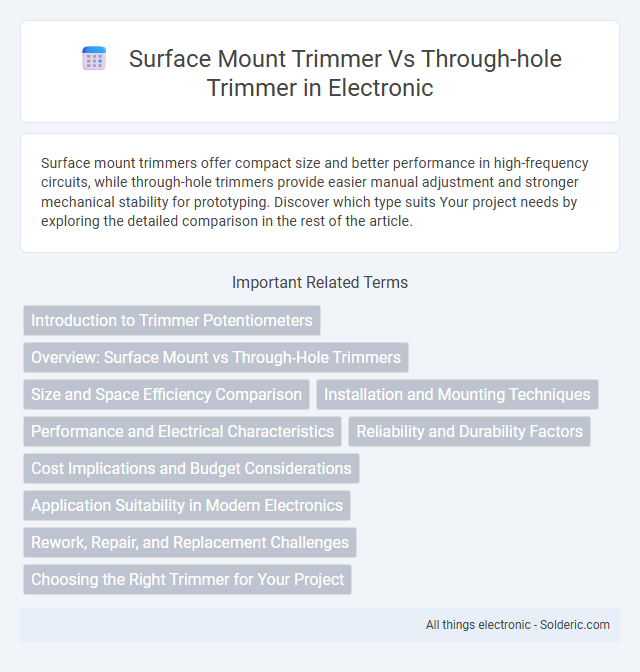Surface mount trimmers offer compact size and better performance in high-frequency circuits, while through-hole trimmers provide easier manual adjustment and stronger mechanical stability for prototyping. Discover which type suits Your project needs by exploring the detailed comparison in the rest of the article.
Comparison Table
| Feature | Surface Mount Trimmer | Through-Hole Trimmer |
|---|---|---|
| Mounting Type | Surface mount (SMT) | Through-hole (THT) |
| Size | Compact, low profile | Larger, bulkier |
| Assembly Process | Automated PCB assembly | Manual or wave soldering |
| Adjustability | Precise, fine tuning | Robust, easier manual adjustment |
| Durability | Good, but sensitive to mechanical stress | Higher mechanical strength |
| Applications | High-density, compact circuits | Prototyping, repair, and rugged designs |
| Cost | Typically lower for mass production | Higher for automated processes |
Introduction to Trimmer Potentiometers
Trimmer potentiometers are adjustable resistors used to fine-tune circuit performance and calibration. Surface mount trimmers are compact and designed for automated PCB assembly, offering space-saving benefits compared to through-hole trimmers, which provide stronger mechanical stability and easier manual adjustment. Choosing the right trimmer depends on Your application's assembly method and space constraints.
Overview: Surface Mount vs Through-Hole Trimmers
Surface mount trimmers are compact, designed for automated PCB assembly, and ideal for high-density circuit boards due to their smaller footprint and ease of soldering with reflow processes. Through-hole trimmers provide robust mechanical stability and are preferred in applications requiring manual adjustments or where environmental stress demands more secure mounting. Your choice depends on the assembly method, space constraints, and the need for durability in the specific electronic application.
Size and Space Efficiency Comparison
Surface mount trimmers offer significant size and space efficiency advantages over through-hole trimmers due to their compact, low-profile design, which allows for higher component density on printed circuit boards (PCBs). Through-hole trimmers require larger mounting holes and more PCB real estate, making them less ideal for modern miniaturized electronic devices. The smaller footprint of surface mount trimmers supports advanced circuit designs where saving space is crucial for functionality and portability.
Installation and Mounting Techniques
Surface mount trimmers feature a flat, compact design that enables direct soldering onto the PCB surface, allowing for automated assembly and saving space in high-density circuits. Through-hole trimmers require inserting leads into drilled holes on the PCB, followed by soldering on the opposite side, providing strong mechanical stability but demanding more manual labor or complex wave soldering processes. Installation of surface mount trimmers supports faster production with pick-and-place machines, while through-hole types are preferred for robust applications where vibration resistance and durability are critical.
Performance and Electrical Characteristics
Surface mount trimmers offer superior high-frequency performance due to reduced parasitic inductance and capacitance compared to through-hole trimmers, enhancing signal integrity in compact circuits. Through-hole trimmers typically provide higher power ratings and greater mechanical stability, making them suitable for applications requiring robust adjustment and durability. Your choice depends on the required electrical precision and environmental resilience in the specific electronic design.
Reliability and Durability Factors
Surface mount trimmers offer enhanced reliability in high-frequency circuits due to their low parasitic inductance and capacitance, which minimizes signal interference and ensures stable performance over time. Through-hole trimmers provide superior mechanical durability because their leads are soldered through the PCB, resisting physical stress and vibration better in harsh environments. You should consider your application's operating conditions, as surface mount trimmers excel in compact, high-speed designs while through-hole trimmers are preferred for robustness and long-term durability in demanding settings.
Cost Implications and Budget Considerations
Surface mount trimmers typically have lower production costs due to automated assembly and smaller size, making them ideal for high-volume manufacturing on tight budgets. Through-hole trimmers often incur higher labor and material costs because of manual assembly and larger PCB space requirements, impacting overall project expenses. Budget considerations should weigh these cost differences alongside application-specific performance and repairability needs.
Application Suitability in Modern Electronics
Surface mount trimmers offer compact size and automated assembly advantages, making them ideal for high-density modern electronics such as smartphones and wearable devices. Through-hole trimmers provide robust mechanical strength and ease of manual adjustment, suitable for prototyping, industrial equipment, and applications requiring frequent tuning. Your choice depends on whether space-saving and automated production or durability and accessibility are primary concerns in the application.
Rework, Repair, and Replacement Challenges
Surface mount trimmers present rework and repair challenges due to their smaller size and limited access, making precise soldering and desoldering more difficult compared to through-hole trimmers. Through-hole trimmers offer easier replacement and inspection since their leads pass through the PCB, allowing more robust mechanical connections and straightforward manual handling. You may find that through-hole trimmers reduce repair time and increase reliability in environments requiring frequent adjustments or replacements.
Choosing the Right Trimmer for Your Project
Selecting the appropriate trimmer depends on your project's size, space constraints, and soldering capabilities; surface mount trimmers offer compactness and are ideal for automated assembly on densely packed PCBs, while through-hole trimmers provide robustness and are easier to adjust or replace manually. Surface mount trimmers suit high-density, miniaturized designs, whereas through-hole trimmers excel in prototyping or applications requiring frequent tuning and mechanical stability. Your choice should align with the technical requirements, assembly process, and long-term maintenance needs of your electronic design.
Surface mount trimmer vs through-hole trimmer Infographic

 solderic.com
solderic.com